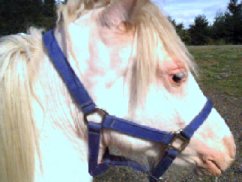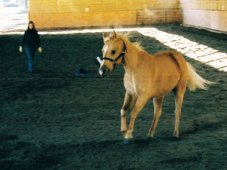Halter Breaking the Foal

Your foal has arrived, you’ve imprinted it (handled it gently right after it was born), spent time with it every day, picked up it’s feet, gently brushed it…now it is 2 months old and time to halter break it. We usually put a halter on our foals by 2 or 3 days old, however we do not try to lead the foal. The halter is used to help the foal get used to handling and as an additional restraint when handling it. That is, not to hold the foal, but to give it the idea that this thing on it’s head is there for a purpose and that purpose is restraint. In the picture below, this halter is a bit too big for Misty.

Exercise 1: Single Step
Before we attach a lead rope to the halter we begin by using the halter with gentle pressure to turn the foal’s head. At the same time we exert pressure we gently push on the foal’s shoulder or neck to encourage it to turn the desired direction. We are only asking for a single step in that direction, whether it is right or left. As soon as the foal takes that step we praise it and scratch it in it’s favorite spot.
Have a lead rope handy for your foal to smell and taste. Foals are a lot like human infants in that they enjoy learning about their environment by mouthing objects. They also tend to paw at things, including people, and this should be discouraged by gently stopping the leg with your hand and saying "NO" in a firm tone, but not loudly.
Your foal is probably used to the lead rope from being around the mare while she is being handled by you. If you have not been around them very much then the time spent familiarizing the foal with the lead rope, halter, handling it’s body and feet should be longer. Be sure to be patient and work slowly and use a gentle voice. Foals are naturally skittish because, after all, they are a favorite food of prey animals in the wild.
Now, for the lessons of leading. Start slowly. Never jerk on the foal’s head, never tug it along or have someone push from behind.
Halter the foal. Don’t make the halter too tight or too loose.
Practice the single step exercise mentioned above. Let the foal smell the lead rope.
Exercise 2: Backward Steps
Attach the lead rope to the halter. Just hold the rope and let the foal feel the weight of it on the halter. The foal may try to back away. Just let it back up and reach the end of the rope. This should only be about 3-4 feet, don’t let it have too much rope. As the foal reaches the end of the rope it will meet with resistance. This may cause the foal to rear up. To prevent this just let the foal feel the pressure for a second or two. Then step toward the foal so the pressure is released. Go to the foal, all the while talking in a calm voice, and reassure it that all is well. Repeat this exercise several times until the foal stands quietly without pulling back when the end of the rope is reached.
Exercise 3: Forward Steps
When exercises 1 & 2 have been successfully completed, which may take a few days (you should not work with the foal for long periods of time as this can stress it) begin to pull gently on the lead rope to try to get the foal to step forward. It is easiest to pull gently to one side or the other, just a little, not a sharp turn. This reminds the foal of the first exercise. It is a good idea to review the first exercise a couple of times immediately prior to this one. If the foal resists, stop and redo exercise one. If the foal takes even one tiny step, stop and praise it lavishly and give it a generous scratch. (Foals are VERY itchy! Rubbing or gently scratching the foal on it’s withers is a good spot. This is the area where the mare nuzzles the foal to reassure it.) Then do it again, and again. Praise the foal for any movement in the right direction…that is taking a step. If the foal resists, do not praise or scratch, just stop, try again. If the foal pulls back, refer to exercise two.
Soon your foal will be taking several steps forward. Praise it each time. This is how you gently train a foal with out gimmicks, ropes and force. We do not believe in forcing an animal to do something it does not understand. Keep in mind that this animal has never had anything but free choice. It is a hard lesson for a foal to learn that it must do what it’s human master wants. Remember when you realized you couldn’t do everything you wanted to?













